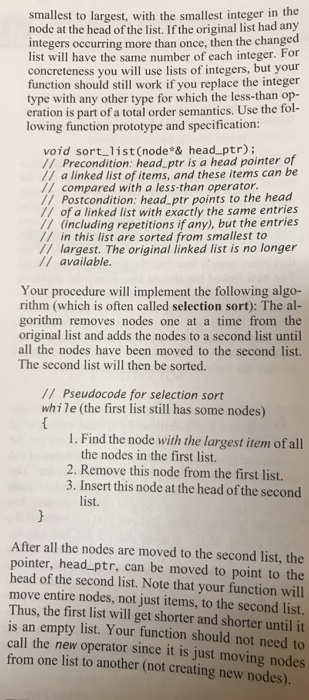Answered step by step
Verified Expert Solution
Question
1 Approved Answer
The goal of this assignment is to reinforce linked lists in C++. Specifically, the assignment is to do programming projects 2, 6, and 7 on
The goal of this assignment is to reinforce linked lists in C++. Specifically, the assignment is to do programming projects 2, 6, and 7 on page 287 of text. Put the required function in "main" and use node1.h and node1.cpp.
node1.cpp
#include "node1.h"
#include // Provides assert
#include // Provides NULL and size_t
using namespace std;
namespace main_savitch_5 {
size_t list_length(const node *head_ptr)
// Library facilities used: cstdlib
{
const node *cursor;
size_t answer;
answer = 0;
for (cursor = head_ptr; cursor != NULL; cursor = cursor->link())
++answer;
return answer;
}
void list_head_insert(node *&head_ptr, const node::value_type &entry) {
head_ptr = new node(entry, head_ptr);
}
void list_insert(node *previous_ptr, const node::value_type &entry) {
node *insert_ptr;
insert_ptr = new node(entry, previous_ptr->link());
previous_ptr->set_link(insert_ptr);
}
node *list_search(node *head_ptr, const node::value_type &target)
// Library facilities used: cstdlib
{
node *cursor;
for (cursor = head_ptr; cursor != NULL; cursor = cursor->link())
if (target == cursor->data())
return cursor;
return NULL;
}
const node *list_search(const node *head_ptr, const node::value_type &target)
// Library facilities used: cstdlib
{
const node *cursor;
for (cursor = head_ptr; cursor != NULL; cursor = cursor->link())
if (target == cursor->data())
return cursor;
return NULL;
}
node *list_locate(node *head_ptr, size_t position)
// Library facilities used: cassert, cstdlib
{
node *cursor;
size_t i;
assert (0
cursor = head_ptr;
for (i = 1; (i
cursor = cursor->link();
return cursor;
}
const node *list_locate(const node *head_ptr, size_t position)
// Library facilities used: cassert, cstdlib
{
const node *cursor;
size_t i;
assert (0
cursor = head_ptr;
for (i = 1; (i
cursor = cursor->link();
return cursor;
}
void list_head_remove(node *&head_ptr) {
node *remove_ptr;
remove_ptr = head_ptr;
head_ptr = head_ptr->link();
delete remove_ptr;
}
void list_remove(node *previous_ptr) {
node *remove_ptr;
remove_ptr = previous_ptr->link();
previous_ptr->set_link(remove_ptr->link());
delete remove_ptr;
}
void list_clear(node *&head_ptr)
// Library facilities used: cstdlib
{
while (head_ptr != NULL)
list_head_remove(head_ptr);
}
void list_copy(const node *source_ptr, node *&head_ptr, node *&tail_ptr)
// Library facilities used: cstdlib
{
head_ptr = NULL;
tail_ptr = NULL;
// Handle the case of the empty list.
if (source_ptr == NULL)
return;
// Make the head node for the newly created list, and put data in it.
list_head_insert(head_ptr, source_ptr->data());
tail_ptr = head_ptr;
// Copy the rest of the nodes one at a time, adding at the tail of new list.
source_ptr = source_ptr->link();
while (source_ptr != NULL) {
list_insert(tail_ptr, source_ptr->data());
tail_ptr = tail_ptr->link();
source_ptr = source_ptr->link();
}
}
Node1.h
// functions, all within the namespace main_savitch_5
//
// TYPEDEF for the node class:
// Each node of the list contains a piece of data and a pointer to the
// next node. The type of the data is defined as node::value_type in a
// typedef statement. The value_type may be any
// of the built-in C++ classes (int, char, ...) or a class with a copy
// constructor, an assignment operator, and a test for equality (x == y).
//
// CONSTRUCTOR for the node class:
// node(
// const value_type& init_data = value_type(),
// node* init_link = NULL
// )
// Postcondition: The node contains the specified data and link.
// NOTE: The default value for the init_data is obtained from the default
// constructor of the value_type. In the ANSI/ISO standard, this notation
// is also allowed for the built-in types, providing a default value of
// zero. The init_link has a default value of NULL.
//
// NOTE:
// Some of the functions have a return value which is a pointer to a node.
// Each of these functions comes in two versions: a non-const version (where
// the return value is node*) and a const version (where the return value
// is const node*).
// EXAMPLES:
// const node *c;
// c->link( ) activates the const version of link
// list_search(c,... calls the const version of list_search
// node *p;
// p->link( ) activates the non-const version of link
// list_search(p,... calls the non-const version of list_search
//
// MEMBER FUNCTIONS for the node class:
// void set_data(const value_type& new_data)
// Postcondition: The node now contains the specified new data.
//
// void set_link(node* new_link)
// Postcondition: The node now contains the specified new link.
//
// value_type data( ) const
// Postcondition: The return value is the data from this node.
//
// const node* link( ) const 



Write a function that takes a linked list of items and deletes all repetitions from the list. In your implementation, assume that items can be compared for equality using // node* link( )
// See the note (above) about the const version and non-const versions:
// Postcondition: The return value is the link from this node.
//
// FUNCTIONS in the linked list toolkit:
// size_t list_length(const node* head_ptr)
// Precondition: head_ptr is the head pointer of a linked list.
// Postcondition: The value returned is the number of nodes in the linked
// list.
//
// void list_head_insert(node*& head_ptr, const node::value_type& entry)
// Precondition: head_ptr is the head pointer of a linked list.
// Postcondition: A new node containing the given entry has been added at
// the head of the linked list; head_ptr now points to the head of the new,
// longer linked list.
//
// void list_insert(node* previous_ptr, const node::value_type& entry)
// Precondition: previous_ptr points to a node in a linked list.
// Postcondition: A new node containing the given entry has been added
// after the node that previous_ptr points to.
//
// const node* list_search(const node* head_ptr, const node::value_type& target)
// node* list_search(node* head_ptr, const node::value_type& target)
// See the note (above) about the const version and non-const versions:
// Precondition: head_ptr is the head pointer of a linked list.
// Postcondition: The pointer returned points to the first node containing
// the specified target in its data member. If there is no such node, the
// null pointer is returned.
//
// const node* list_locate(const node* head_ptr, size_t position)
// node* list_locate(node* head_ptr, size_t position)
// See the note (above) about the const version and non-const versions:
// Precondition: head_ptr is the head pointer of a linked list, and
// position > 0.
// Postcondition: The pointer returned points to the node at the specified
// position in the list. (The head node is position 1, the next node is
// position 2, and so on). If there is no such position, then the null
// pointer is returned.
//
// void list_head_remove(node*& head_ptr)
// Precondition: head_ptr is the head pointer of a linked list, with at
// least one node.
// Postcondition: The head node has been removed and returned to the heap;
// head_ptr is now the head pointer of the new, shorter linked list.
//
// void list_remove(node* previous_ptr)
// Precondition: previous_ptr points to a node in a linked list, and this
// is not the tail node of the list.
// Postcondition: The node after previous_ptr has been removed from the
// linked list.
//
// void list_clear(node*& head_ptr)
// Precondition: head_ptr is the head pointer of a linked list.
// Postcondition: All nodes of the list have been returned to the heap,
// and the head_ptr is now NULL.
//
// void list_copy(const node* source_ptr, node*& head_ptr, node*& tail_ptr)
// Precondition: source_ptr is the head pointer of a linked list.
// Postcondition: head_ptr and tail_ptr are the head and tail pointers for
// a new list that contains the same items as the list pointed to by
// source_ptr. The original list is unaltered.
// void list_piece(
// const node* start_ptr, const node* end_ptr,
// node*& head_ptr, node*& tail_ptr
// )
// Precondition: start_ptr and end_ptr are pointers to nodes on the same
// linked list, with the start_ptr node at or before the end_ptr node
// Postcondition: head_ptr and tail_ptr are the head and tail pointers for a
// new list that contains the items from start_ptr up to but not including
// end_ptr. The end_ptr may also be NULL, in which case the new list
// contains elements from start_ptr to the end of the list.
//
// DYNAMIC MEMORY usage by the toolkit:
// If there is insufficient dynamic memory, then the following functions throw
// bad_alloc: the constructor, list_head_insert, list_insert, list_copy,
// list_piece.
#ifndef MAIN_SAVITCH_NODE1_H
#define MAIN_SAVITCH_NODE1_H
#include // Provides size_t and NULL
namespace main_savitch_5 {
class node {
public:
// TYPEDEF
typedef double value_type;
// CONSTRUCTOR
node(
const value_type &init_data = value_type(),
node *init_link = NULL
) {
data_field = init_data;
link_field = init_link;
}
// Member functions to set the data and link fields:
void set_data(const value_type &new_data) { data_field = new_data; }
void set_link(node *new_link) { link_field = new_link; }
// Constant member function to retrieve the current data:
value_type data() const { return data_field; }
// Two slightly different member functions to retreive
// the current link:
const node *link() const { return link_field; }
node *link() { return link_field; }
private:
value_type data_field;
node *link_field;
};
// FUNCTIONS for the linked list toolkit
std::size_t list_length(const node *head_ptr);
void list_head_insert(node *&head_ptr, const node::value_type &entry);
void list_insert(node *previous_ptr, const node::value_type &entry);
node *list_search(node *head_ptr, const node::value_type &target);
const node *list_search
(const node *head_ptr, const node::value_type &target);
node *list_locate(node *head_ptr, std::size_t position);
const node *list_locate(const node *head_ptr, std::size_t position);
void list_head_remove(node *&head_ptr);
void list_remove(node *previous_ptr);
void list_clear(node *&head_ptr);
void list_copy(const node *source_ptr, node *&head_ptr, node *&tail_ptr);
}
#endif
Programming project 2,6,7
(2)

(6)

(7)


Step by Step Solution
There are 3 Steps involved in it
Step: 1

Get Instant Access to Expert-Tailored Solutions
See step-by-step solutions with expert insights and AI powered tools for academic success
Step: 2

Step: 3

Ace Your Homework with AI
Get the answers you need in no time with our AI-driven, step-by-step assistance
Get Started


